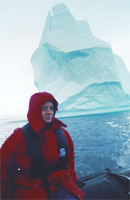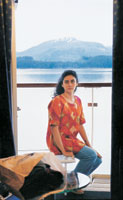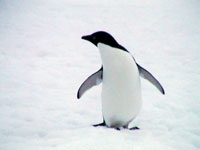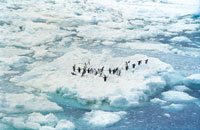


 A Trip To The Extremities Of The Earth!
A Trip To The Extremities Of The Earth!
URMI POPAT continues her icy cold travelogue, this time to the Antarctic, which inspired her to put down her invigorating experiences in the form of a glossy, coffee table book. |
|
Unending expanse of snow, bitingly chill weather, Penguins� These are the images one generally associates with Antarctica. This icy continent evoked ineffable curiosity and for years my father had longed to visit it. For several years, he kept enquiring if there was anyway he could be a part of an expedition to Antarctica, but to no avail�
Eventually, I too got curious about these regions, which most claimed �was too far truly for most�! As they say, when something is forbidden or unattainable, it becomes
all the more irresistible and thus, we finally got our answer in the year 2002.
Antarctica is truly known for all the extremes � coldest, windiest, driest, highest and the most inhospitable continent in the world. All these factors obviously in combination
inhibit the formation of the types of soil needed to sustain plant and animal life on land. Hence, there is no sight of flora, fauna or human life here.
The only hurdle on such a tour is the packing required before departure. As there are no shops or any place even for basic requirements in Antarctica, you have to meticulously make a list of items that might be needed over there. No
matter how much you prepare, you will always be at the mercy of the continent�s ever-changing weather conditions.
The preparation for our �once-in-a-lifetime� journey began several months prior to our travel date. First and foremost, we had to send our medical fitness reports to our Expedition operators in the US as per the governing rules of the International Association of Antarctica Tour Operators (IAATO). There is no visa required to visit Antarctica and so paper work had to be done only for the countries that we would visit en route.
If one has to enjoy any such utterly cold place to its fullest, it is important to take all the necessary precautions. In order to regulate the body�s exchange of heat with the surroundings, it is important to dress right in a cold climate. Care should be taken to see that the hands, feet and head are particularly well protected to avoid any chances of frostbite.
While passing through the �roaring� 40-degree�, �furious� 50-degree and the �screaming� 60-degree South latitude (called the Drake Passage) to reach Antarctica, one often gets seasick in spite of the several medicines, acupressure wristband and medicated patch put behind the ear as the sea here is very rough. Thanks to seasickness, some of us touched no food for a good two days. Because of the rough sea, utmost care was taken to avoid any damage and casualties in the ship. The tables and chairs were all tightly fixed to the floor. The
crockery was placed on a wet tablecloth to avoid sliding. There were handrails in the passages and toilets, without which we would have surely bruised ourselves. At times the ship would sway to such an extent, that while seated in the restaurant, one could see the ocean from one side of the window and the sky on the opposite side. The four days spent to navigate through the Drake Passage, while traveling to and returning from Antarctica, were no less than a nightmare.
The sound of over 50,000 penguins braying and clucking created a unique cacophony that no one could forget for a long time to come. Penguins had certainly entertained us at every port of call on this trip. They engaged in wide array of playful antics - including wrestling with each other and slapping the water vigorously. A number of heavily glaciated, low peaks
create dramatic backdrop to the gleaming islands of the Antarctic Peninsula.
I must acknowledge that special care was special care taken to prepare delicious vegetarian food onboard our Antarctican cruise. The humidity here is two per cent due to which one gets dehydrated. Because of this low humidity, we would wake up in the middle of the night feeling very thirsty and gulp down litres of water, yet, the thirst would not be quenched.
There is hardly anything to buy in Antarctica although there are some scientific stations that sell printed T-shirts,
coffee mugs and other souvenirs. Research stations are the only structures constructed here. So people who are on a lookout for malls, theme parks, hotels etc. would be disappointed, as there are no such places. The hostile environment of Antarctica does not permit any kind of permanent infrastructure for the tourists. Nature lovers are sure to be delighted, as it is the most spiritual and beautiful land on earth surpassing one�s hopes and dreams. Recreation is thus limited to only what your mind is capable of conceiving.
In conclusion, the trips to the �extremities of the earth� were an enlightening experience. The feeling that, this could well be the first and last trip of ours to these places, made us realise how lucky we were to get at least one chance to see how blessed some places were, by nature!
Urmi Popat�s book Arctic and Antarctic � Journeys to The Extremities of The Earth was presented to Dr. APJ Abdul Kalam, President of India, at the Rashtrapati Bhuvan. It is available at leading bookstores and can also be ordered from Manas Publication, Mumbai. www.manaspublication.com
|

Home Page
About the mag
Subscribe
Advertise
Contact Us
 The joy doubled, when we as a family could proudly sing, �Happy Birthday� and usher in my father�s 60th year in a place he had always dreamed of!
If you think Antarctica has only one climate � bitingly chill, you will be surprised! Antarctica has several climates �though all cold, they differ considerably in severity. The world�s lowest temperature of -89.6 degree C was recorded in Antarctica in July 1983. Antarctica has a very short summer (with almost 24 hours daylight) from November to February, and a very long winter from March to October (with almost 24 hours nightfall), which means for half of the year, most of Antarctica lies in darkness. The average temperatures range from -40 to -70 degree C and -15 to -35 degree C in winter and -15 to -35 degree C and 0 to -6 degree C in summer, in the interior and coastal regions respectively. From March to November, Antarctica is left to the over-wintering scientific bases and their crews. Tourist ships could possibly get in and out of the continent earlier or later in the season, but there is always the imminent danger of not reaching the places on the itinerary, or worse, of getting stuck in the sea-ice, as has occasionally happened on the scientific bases.
The joy doubled, when we as a family could proudly sing, �Happy Birthday� and usher in my father�s 60th year in a place he had always dreamed of!
If you think Antarctica has only one climate � bitingly chill, you will be surprised! Antarctica has several climates �though all cold, they differ considerably in severity. The world�s lowest temperature of -89.6 degree C was recorded in Antarctica in July 1983. Antarctica has a very short summer (with almost 24 hours daylight) from November to February, and a very long winter from March to October (with almost 24 hours nightfall), which means for half of the year, most of Antarctica lies in darkness. The average temperatures range from -40 to -70 degree C and -15 to -35 degree C in winter and -15 to -35 degree C and 0 to -6 degree C in summer, in the interior and coastal regions respectively. From March to November, Antarctica is left to the over-wintering scientific bases and their crews. Tourist ships could possibly get in and out of the continent earlier or later in the season, but there is always the imminent danger of not reaching the places on the itinerary, or worse, of getting stuck in the sea-ice, as has occasionally happened on the scientific bases.
 There are no indigenous people on Antarctica, which means, there is no one who is called an �Antarctican�.
Tours to Antarctica take place in the �Austral Summer� when the sun finally emerges after the long winter night. For most travellers, an escorted tour/cruise is the way to visit the continent. Large ships cruise around the Antarctic Peninsula, sometimes employing helicopters or rubber Zodiac boats to take passengers ashore. Once ashore the passengers are divided into small groups and then along with the escort they set off to explore the island. Such escorts generally include ornithologists, marine biologists, general biologists, geologists, glaciologists, historians and naturalists � all experts in their respective fields. In the absence of medical facilities in the Antarctic, it is of utmost importance that the traveler is in good health for the excursion, which would require moderate exertion.
There are no indigenous people on Antarctica, which means, there is no one who is called an �Antarctican�.
Tours to Antarctica take place in the �Austral Summer� when the sun finally emerges after the long winter night. For most travellers, an escorted tour/cruise is the way to visit the continent. Large ships cruise around the Antarctic Peninsula, sometimes employing helicopters or rubber Zodiac boats to take passengers ashore. Once ashore the passengers are divided into small groups and then along with the escort they set off to explore the island. Such escorts generally include ornithologists, marine biologists, general biologists, geologists, glaciologists, historians and naturalists � all experts in their respective fields. In the absence of medical facilities in the Antarctic, it is of utmost importance that the traveler is in good health for the excursion, which would require moderate exertion.
 We were a little skeptical as to how safe the journey would be, as we could not have any first hand information and added to that, we had no prior information or prior experience with our expedition agent. We had come to know of our agents only through the net.
Finally the day of our departure to Antarctica dawned. We left with heavy luggage, which was crammed with all the worldly possessions one could think of and more than
anything, weighing quite heavy with the loads of wishes which we were carrying from our near and dear ones hoping to
survive the cold. Our tour started at Ushuaia, in Argentina, the southernmost city of the world where we found our ship �The World Discoverer� and her 100 crewmembers busy preparing for our expedition. At Ushuaia we enjoyed the pristine scenery and also enjoyed a typical Fueguian lunch at an isolated mountain resort located a mere 625 miles from Antarctica.
We were a little skeptical as to how safe the journey would be, as we could not have any first hand information and added to that, we had no prior information or prior experience with our expedition agent. We had come to know of our agents only through the net.
Finally the day of our departure to Antarctica dawned. We left with heavy luggage, which was crammed with all the worldly possessions one could think of and more than
anything, weighing quite heavy with the loads of wishes which we were carrying from our near and dear ones hoping to
survive the cold. Our tour started at Ushuaia, in Argentina, the southernmost city of the world where we found our ship �The World Discoverer� and her 100 crewmembers busy preparing for our expedition. At Ushuaia we enjoyed the pristine scenery and also enjoyed a typical Fueguian lunch at an isolated mountain resort located a mere 625 miles from Antarctica.
 And as the ship cut the thin ice layer on the third day of our journey and went ahead, the amazing crash action got an �OOOOH-AAH� from all of us. The pain of the Drake Passage is easily forgotten after experiencing the overwhelming beauty of numerous gigantic tabular icebergs (almost 10-15 storey high) all around the ship.
Lo and behold! As we made our first landing ashore before we could even blink, we saw hundreds of Penguins all around the place. We had to pinch ourselves to believe that we were actually in Antarctica and not seeing some programme on the National Geographic. The Antarctic Treaty of 1959 enjoins all humans to minimise interference with the normal living conditions of any native animal or bird. And so even though we were tempted to cuddle the penguins, we had to really resist ourselves from doing so. We had to be content by admiring them from an obligatory distance of a couple of meters.
And as the ship cut the thin ice layer on the third day of our journey and went ahead, the amazing crash action got an �OOOOH-AAH� from all of us. The pain of the Drake Passage is easily forgotten after experiencing the overwhelming beauty of numerous gigantic tabular icebergs (almost 10-15 storey high) all around the ship.
Lo and behold! As we made our first landing ashore before we could even blink, we saw hundreds of Penguins all around the place. We had to pinch ourselves to believe that we were actually in Antarctica and not seeing some programme on the National Geographic. The Antarctic Treaty of 1959 enjoins all humans to minimise interference with the normal living conditions of any native animal or bird. And so even though we were tempted to cuddle the penguins, we had to really resist ourselves from doing so. We had to be content by admiring them from an obligatory distance of a couple of meters.
 We did not realise how quickly our two week tour came to an end. It was just not enough, but nevertheless it was a good introduction to the landscape and life on Antarctica. It
transcended all my hopes � none of the books you read,
photos and movie clippings you see, prepare you for actually being there in the most divine and beautiful landscape of the world. The sheer proportions and astounding beauty of Earth�s least touched continent is still sinking in. It will take some time before I can comprehend how grand the Antarctic is!
We did not realise how quickly our two week tour came to an end. It was just not enough, but nevertheless it was a good introduction to the landscape and life on Antarctica. It
transcended all my hopes � none of the books you read,
photos and movie clippings you see, prepare you for actually being there in the most divine and beautiful landscape of the world. The sheer proportions and astounding beauty of Earth�s least touched continent is still sinking in. It will take some time before I can comprehend how grand the Antarctic is!